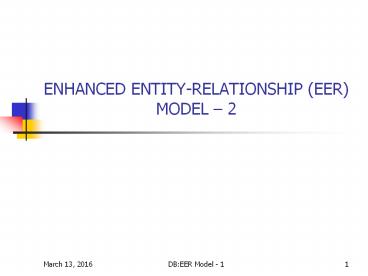ENHANCED ENTITY-RELATIONSHIP (EER) MODEL - PowerPoint PPT Presentation
Title:
ENHANCED ENTITY-RELATIONSHIP (EER) MODEL
Description:
Insertion and Deletion Rules Hierarchies and Lattices S/G Conceptual Data ... entity then we define its (overlapping) subclasses EMPLOYEE, ALUMNUS, STUDENT. ... – PowerPoint PPT presentation
Number of Views:65
Avg rating:3.0/5.0
Title: ENHANCED ENTITY-RELATIONSHIP (EER) MODEL
1
ENHANCED ENTITY-RELATIONSHIP (EER) MODEL 2
2
Objectives
- Insertion and Deletion Rules
- Hierarchies and Lattices
- S/G Conceptual Data Modeling
- Categorization
- Conceptual Object Modeling
- Higher Degree Relationships
3
- Insertion and Deletion Rules
- Deleting an entity from a superclass implies
that it is automatically deleted from all
subclasses to which it belongs. - Inserting an entity into a superclass implies
that the entity is mandatorily inserted in all
predicate-defined (or attribute-defined)
subclasses for which the entity satisfies the
defining predicate. - Inserting an entity into a superclass of a total
specialization implies that the entity is
mandatorily inserted in at least one of the
subclasses of the specialization
4
- Hierarchies and Lattices
- A subclass itself may have further subclasses on
it, forming a hierarchy or a lattice of
specialization. - In a hierarchy every subclass participates as a
subclass in only one superclass/subclass
relationship. - In a lattice a subclass may participate as
subclass in more than one superclass/subclass
relationship. - A subclass with more than one superclass is
called a shared subclass. - A shared subclass inherits attributes and
relationship from multiple superclasses,
resulting in having multiple inheritance.
5
-- Example of a Lattice
6
- S/G Conceptual Data Modeling
- In the specialization process, we typically start
with an entity type and then define its
subclasses by successive specialization. This
process is top-down conceptual refinement process
during the conceptual schema design. - The example show in the this figure of a
university database shows this process. We start
by the PERSON entity then we define its
(overlapping) subclasses EMPLOYEE, ALUMNUS,
STUDENT. We continue this process until we get
all the subclasses shown in the figure. - Another method of reaching the same lattice is
through a bottom-up conceptual synthesis process.
We start by identifying the entity types that
actually represent the subclasses. Then the
generalization is used to collect the common
attributes and relationships between subclasses
to create the superclasses, and so on.
7
-- Example Conceptual Modeling
8
(No Transcript)
9
- Categorization
- Categorization (Union) is the modeling of a
single subclass (called a category) with a
relationship that involves more than one distinct
superclasses. (see this Figure) - The difference between category and a shared
subclass is that a shared subclass entity must be
a member of all the superclass entities
(intersection) whereas a category is a subset of
the union of its superclasses. Hence an entity
which is a member of a category must exist in
only one of the superclasses. - In a category, subclass has selective
inheritance. - Categories can be either total or partial.
- Total every occurrence of all superclass must
appear in the category. - Partial Some occurrences of all superclasses may
not appear in the category.
10
(No Transcript)
11
-- Example Categorization
12
- Conceptual Object Modeling
- Object modeling methodology, such as UML
(Universal Modeling Language) and OMT (Object
Modeling Technique) are becoming increasingly
popular. - Although these methodologies were developed
mainly for software design, but they can be used
in the database design. - The class diagrams of these methodologies are
similar to the EER diagrams in many ways.
13
(No Transcript)
14
- Higher Degree Relationships
- In many instances, it is required to represent
relationship that is of a degree higher than 2
(HD), i.e. it involves more than two entity
types. - Sometime these relationships can be represented
using binary relations, although sometime this
may not give the same meaning. - For example the tuple (s, p, j) which states that
SUPPLIER s supplies PART p to PROJECT j may not
be expressed by the three tuples (s,p), (s,j) and
(p,j).
15
-- Example Higher Degree Relationships































